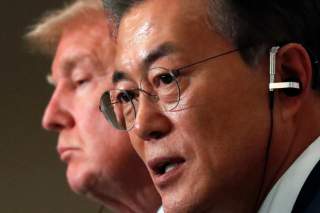5 Things South Korea Can Do to Wrest Control from Washington
A glance at a map of the Korean Peninsula shows why the interests of Washington and Seoul diverge when it comes to preventive war.
Fourth, Seoul should develop a long-range strategy for further strengthening ties with China. South Korea is infinitely more important to China than North Korea, no matter what index of power one uses, and Sino-South Korean relations are not encumbered by the historical legacies that divide China and Japan. Increasing China’s (already considerable) stake in a productive relationship with South Korea will provide Seoul greater leverage over Pyongyang, which depends on China heavily, even as it defies and frustrates the Beijing leadership. Seoul would also be well served by a new China policy because of the shift that has been underway in the regional balance of power. Over the past two decades, China has gained the military muscle needed to raise the price the United States must pay to project military power into the North Pacific in wartime. Thus, as China grows stronger—which it will, barring an internal crisis—Seoul risks getting caught in the middle of an intensifying rivalry, and as the value of American protection diminishes. South Korea would be foolish to part company with the United States, but that it should position itself to make the new balance of power work to its advantage. That will require a departure from entrenched modes of thinking.
In the short term, South Korea must decide just how much protection the American THAAD provides and whether it should relinquish it as part of a substantial quid pro quo with Beijing. This means reassessing how well the system would fare against a North Korea missile barrage that incorporates measures designed to foil the system and the extent to which THAAD can protect South Korea’s most vulnerable and important locale, Greater Seoul, home to half the country’s population. The system consists of forty-eight interceptors and a highly advanced radar. It is based in Seongju county in southern South Korea, which is about 135 miles from Seoul. Missile expert Theodore Postol and others have raised questions about the effectiveness of THAAD on both counts. Seoul would do well to consider them.
Fifth, Seoul should propose and build support for a plan that reduces the risk of war on the peninsula, promotes economic development in Northeast Asia, strengthens interdependence, and provides North Korea with incentives to join as a stakeholder. President Moon’s recently released plan, “A Peninsula for Peace and Prosperity,” represents welcome step in this direction. It proposes various initiatives: an affirmation that South Korea does not desire, and will not seek to engineer, a North Korean collapse and pursue unification solely through cooperative, coordinated means; the resumption of political contacts and exchanges; the establishment of procedures aimed at “military trust-building” on the peninsula; and multilateral investments to create “three economic belts” that connect the Korean Peninsula, China and Russia. Admittedly, these ideas are general and the parts aimed at persuading Pyongyang to dismantle its nuclear program unrealistic. Nevertheless, Moon deserves credit. He has developed an authentically South Korean plan. Moreover, it offers a refreshing alternative to Trump’s approach, which assumes that threats, or if need be war, will work, or that China will somehow deliver a denuclearized North Korea in anticipation of economic rewards from the United States.
These five points rest on the assumption that South Korea must chart a more independent course and can to do so because of the impressive economic and military resources it has amassed. As a starting point, Seoul should make clear to Washington where South Korea’s interests converge with those of the United States and where they do not, specify what its “red lines” are, and present bold initiatives that demonstrate that it has the confidence to steer the ship and will not settle for being a passenger. This much is clear: Seoul cannot continue business as usual. Too much has changed—and more change is on the way.
Rajan Menon is an Anne and Bernard Spitzer Professor of International Relations at the Powell School, City College of New York/City University of New York. He is also a senior research scholar at Columbia University’s Saltzman Institute of War and Peace Studies, and author of The Conceit of Humanitarian Intervention.

